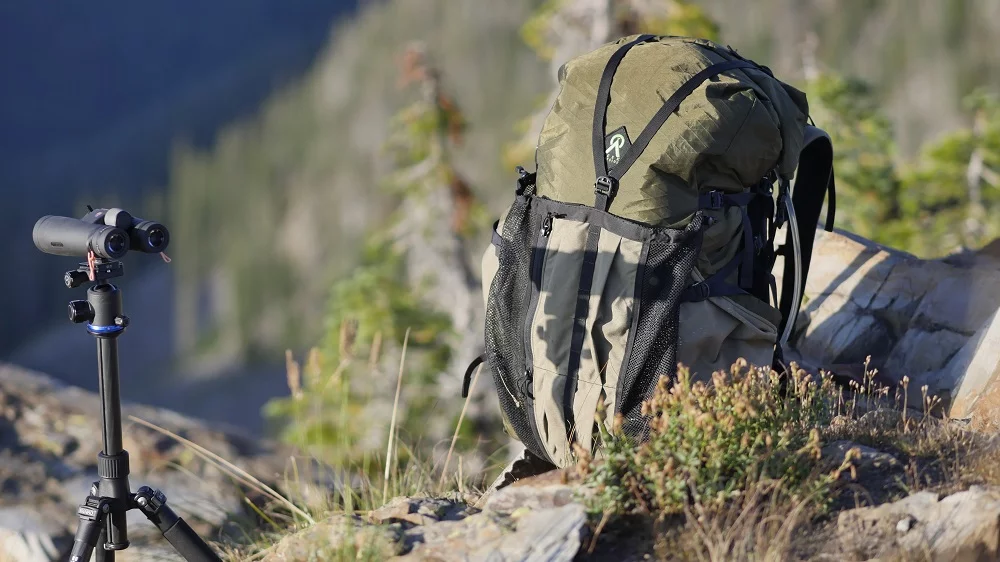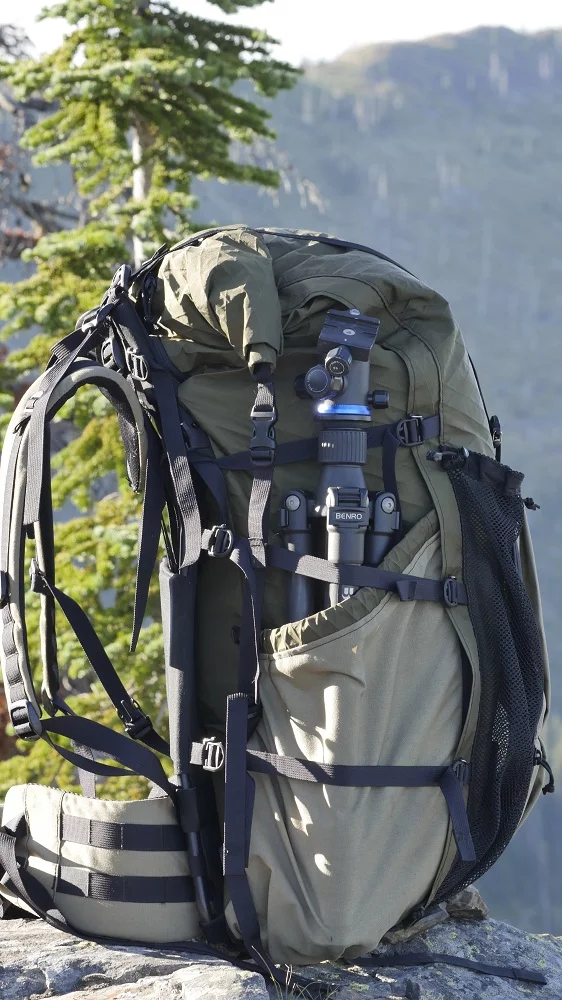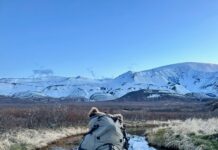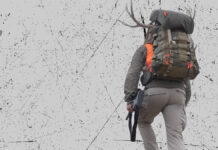
As I drove into the small parking area of the remote trailhead, my friend Jared Lampton stepped out of his vehicle with a grim look on his face. I jumped out to greet him and offer up congratulations on killing another backcountry bull. Noticing he doesn’t have a passenger along I ask if anyone else is coming when he solemnly mentions it’s just the two of us. The task will be hefty with packing a large portion of his camp out along with three quarters of the bull. With no other recourse, we shoulder our Seek Outside packs and start the long trip up and over the mountain. This would be my first real test with the Lanner 5400.
Several hours later, we boned the quarters for packing and split various pieces of camp between us. That’s when I noticed how his pack was swallowing gear like a black hole, and as we started our hike out of the mountains, how well it was handling the oversized load. It wasn’t an unfamiliar sight, as we’ve packed out several of each other’s elk over the years and he has been using the same pack every season since 2013. It’s the original Seek Outside frame and bag (previously called Paradox Packs) and has served him well over the years. We spent the rest of the day grinding down the trail and I wondered how the updated version of the frame and bag would perform. Jared’s review on the original frame can be read here if you are interested in his take on the pack.

Seek Outside Lanner 5400
In early January of 2019, I was offered an opportunity to test a Lanner 5400. As a backpack hunter I am always keen on trying new gear to see if I can optimize my backcountry kit. Matt Cashell reviewed the Revolution frame, harness, and smaller Peregrine 3500 bag in 2018. He was impressed with the pack and its function which further piqued my curiosity. Matt’s review can be read here.
Features
The frame I’ve been using has 24-inch stays with 2-inch removable extensions. The belt is a medium and has a removable lumbar pad added. The bag is built of X-pack fabric and is a similar design to the Peregrine but has a larger main bag. Both have a roll-top closure, full side zip access, large dual side pockets, zippered security pockets, and a hybrid mesh stuff pocket. The Lanner has a small zippered pocket on the shroud that functions as a lid when compressed with a day-sized load. The difference in volume comes from the Lanner’s larger top and bottom circumference and taller height. The full specs can be found here. The pack as assembled above, including a belt accessory pocket, weighs 5.46 pounds.
The Lanner is designed as a 7 to 10-day pack with the ability to compress the bag into a day hunting pack that still offers organization and quick access to gear. The breakaway concept of hauling a heavy load of meat between the frame and bag adds to the versatility of the pack system.

The compression straps are removable with gatekeeper buckles at each end of the strap. This allows for quick attachment and removal of straps for a custom configuration depending on load compression needs.
Use in the field
The frame extensions on the Revolution platform are worth the effort of switching them in and out for specific conditions. I initially used the pack with the extensions installed and found the top of the frame would limit my ability to look up steep slopes. Also, the longer stays were more prone to snag overhead limbs and brush. After removing the 2-inch extensions, the headroom improved and the pack cleared obstacles much better. Conversely when heavy loads need to be strapped on, adding the frame extensions allow for more lift, control, and comfort. Frame extensions of 2 inches or 4 inches can be added to the main 24-inch frame. For reference, my torso length is 17.5 inches so the 2-inch extension is enough to get proper lift. If your torso is longer contact Seek Outside for their recommendation.

The frame has remained creak-free in the lower pivot area, the cross stay, and at the belt and harness attachment points. The added cross stay keeps the frame from barreling when under heavy compression and keeps air flowing along the back. The ventilation of the frame is similar to other packs on the market with the main warm spot being along the harness area, parts of the back panel, and waist belt.
Waist Belt
I used the belt in the captured configuration as well as floating, and have settled on using it in the floating position. With small day loads it didn’t feel better one way or the other, but after spending some time packing weight the floating configuration wrapped around my iliac crest better. This transferred weight to my waist more efficiently. Also, the lumbar pad made a difference in the belt fit for me, but other back shapes may differ. The same can be said of the waist belt buckle. The dual-buckle was not comfortable for me at all and I swapped it to the quad buckle for a more personalized fit. Again, end-user preference will vary, but be aware there is another option if the standard two buckle design isn’t comfortable.

Like Matt in his review, I was a little doubtful on the robustness of the gatekeeper compression strap system but have not had any failures despite my tendency to crank down compression straps. The ability to add, move, and remove them is really convenient. Over the course of testing, I have found that having a minimal amount of compression straps on the pack keeps it feeling more streamlined without the unnecessary straps flapping around.
The Lanner 5400 bag is generous in volume and can handle a 10-day hunt with ease. Yet with smaller loads, the bag easily compresses. For day hunts it is not overly cumbersome with its roll-top configuration. The side pockets are huge and hold a spotting scope and tripod with ease plus room for other gear. The mesh stuff pocket is perfect for stowing layers as they get shed during the day. And I really like the small zippered pockets for organizing. They are the perfect balance of sizes and not too numerous to clutter and confuse.

The X-pac fabric is waterproof and has kept the interior mostly dry in some serious rain. There were a few days of use in British Columbia where water penetrated the interior via the seams but only enough to dampen it a little. Seam sealing it would eliminate most water issues.
The ideal user of this pack is someone looking for a larger bag for longer multi-day trips yet wants a bag that can be compressed for day hunts from a base camp. The volume of the fully extended bag will swallow cold weather gear and food without an issue yet will compress and roll into a great 2400 cubic inch day hauler. When seam sealed, it is also an ideal system for hunters in wet climates with the waterproof qualities of the X-pac fabric. The versatility of the frame configurations allows for complete customization to fit a wide range of body shapes and hauling needs making it a great choice for most backpack hunters out west.

The Seek Outside Lanner 5400 retails for $529 which includes the frame and bag. The lumbar pad is $35 and the 2 inch and 4-inch stay extensions are $10 and $12. Give them a call (970) 208-8108 for their recommendations on the perfect pack system for your needs. Or you can order here on their website.
You can also comment on this review or ask Josh questions here.



















